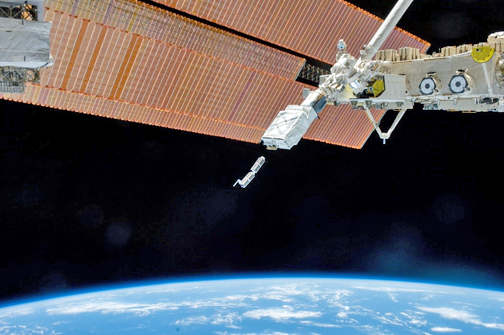
Smallsat launching from the International Space Station. Photo is courtesy of NASA.
Aboard the Orbital ATK Cygnus flight to the ISS, following a successful launch by a United Launch Alliance Atlas V rocket, were 38 smallsats, all meeting the manufacturing size requirements for CubeSats. Twenty-eight of these satellites ad part of the QB50 mission that is funded by the European Commission (EC) and managed by the von Karman Institute for Fluid Dynamics, with NanoRacks being the launch provider. — these smallsats included…
Australia
Inspire-2 from the University of Sydney with a Langmuir probe payload, SUSat from the University of Adelaide and the UNSW-EC0 from the University of New South Wales. The latter two smallsats carry ion-neutral mass spectrometers.
Belgium
Harbin Institute of Technology’s LilacSat-1 with an Ion-Neutral Mass Spectrometer (INMS).
Canada
Ex-Alta 1 from the University of Alberta, designed to measure conditions in Earth’s magnetic field, carries a Multi-Needle Langmuir Probe (m-NLP) as a payload.
China
Nanjing University of Science and Technology with NJUST-1 and an INMS payload.The Northwestern Polytechnical University’s smallsat Ao Xiang 1 with a Flux-Phi Probe Experiment (FIPEX) payload.
Finland
The nation's first satellite, the Aalto-2, is hosting a m-NLP probe.
France
École Polytechnique and École des Mines Aristech and their X-CuveSat and SpaceCube smallsats with FIPEX payloads.
Germany
Technical University of Dresden, the Student’s Oxygen Measurement Project 2 (SOMP-2) with FIPEX payload.
Greece
UPSat and DUTHSat, with UPSat being the first one to be based on open-sources software. The first satellite was built by the University of Patras and the Libre Space Foundation and the second one by the University of Thrace. Both satellites carry a Multi-Needle Langmuir Probe (m-NLP).
Israel
Herzliya Science Center’s Hoopoe smallsat with m-NLP payload.
Puerto Rico
The Universidad del Turabo’s Columbia smallsat and its FIPEX payload.
South Africa
nSight-1 and ZA-AEROSAT from SCS-Space and Stellenbosch University with FIPEX payloads.
South Korea
Three smallsats. Seoul National University’s SNUSAT-1 and SNUSAT-1b packing FIPEX payloads, with the Korea Advanced Institute of Science and Technology (KAIST) including their Little Intelligent Nanosatellite of KAIST (LINK) which is equipped with an INMS payload.
Spain
Universidad Politécnica de Madrid’s QBITO smallsat with INMS payload.
Sweden
Lula University of Technology and partner Open Cosmos of England with their qbee50-LTU-OC smallsat with FIPEX payload.
Taiwan
National Cheng Kung University has their Phoenix smallsat included with an INMS payload.
Turkey
Istanbul Technical University and Halvesan (a defence contractor in that nation owned by the government) with their BeEagleSat and HAVELSAT smallsats, both with m-NLP payloads.
Ukraine
National Technical University and the PolyITAN-2 SAU smallsat, also with FIPEX payload.
United States
California State University at Northridge
The Northridge Satellite 1, AKA CSUNSAT-1, to test a new power system that doesn’t require radiators.
Millennium Space Systems
Altair Pathfinder, a six-unit CubeSat, to demo the company’s Altair Core bus.
Morehead State University
The Cosmic X-Ray Background 2 (CXBN-2) smallsat which will measure background x-ray levels.
NASA
Included aboard Cygnus is the agency’s Educational Launch of Nanosatellites, known as the ELaNa program, with this bevy of satellites including IceCube (also known as Earth 1) from the Goddard Space Flight Center, which will be testing a new radiometer for cloud observations from orbit. A second NASA smallsat remains unidentified as of this writing.
National Reconnaissance Office (NRO)
Biarri-Point pathfinder smallsat for Australia, Canada, United Kingdom and the United States to test out formation flying satellites for military use.
Spire Global
Four Lemur-2 spacecraft, weather satellites, deployed directly from Cygnus, with STRATOS and SENSE payloads, to monitor the atmosphere of Earth and as AIS signal receivers.
University of Colorado
Challenger with an INMS payload.
University of Michigan
Atlantis with a FIPEX payload.

